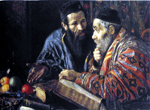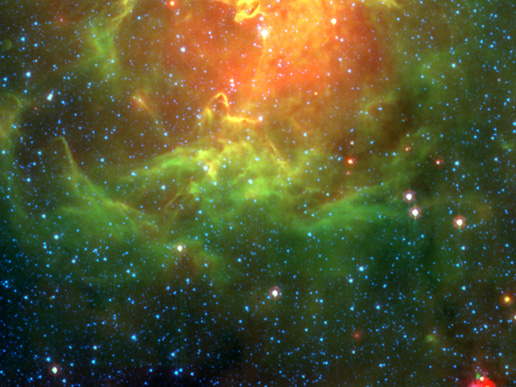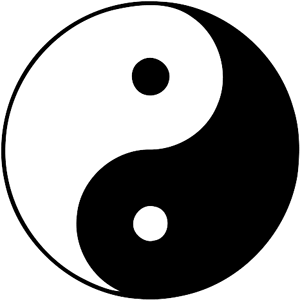


Before a grandson of the “holy Yehudi,” a zaddik of the seventh generation, a merchant brought a complaint against another who had opened a business next to him and reduced his profits. “Why,” asked the zaddik, “do you attach yourself so to the business by which you nourish yourself? What really matters is to pray to Him who nourishes and preserves! But perhaps you do not know where He dwells; now then, it is written, ‘Love thy fellow as one like thyself, I am the Lord.’ Only love him, your fellow, and wish that he too may have what he needs, - there, in this love, you will find the Lord.” (Ref. 1: Buber, p. 230)

Note to the student:
What great treasures of wisdom lie hidden in this sacred anecdote! What a blessing it is that you have come to seek them out!
"For so great is thy love for me that Thou hast rescued my soul from the depths of Sheol." (From a prayer of Dovid HaMelech, Ps. 86:13, NJB)
Commentary
To briefly recap our previous lectures: a merchant has come to the local tzaddik seeking help in his business, the profits of which have been diminished by a new competitor. The tzaddik has counseled the merchant to the effect that it is not one’s business that nourishes, but God. Therefore, the merchant should free himself of his attachment to his business and instead attach himself through prayer to God. Sensing, perhaps, some puzzlement on the part of the merchant, the tzaddik then says: "But perhaps you do not know where He dwells…"Ah, indeed! That is the issue, is it not? Where does God dwell, that we may approach Him, that we may attach ourselves to Him in worship and prayer? The answer to that question, of course, depends on which God you mean, for God has many faces and many names. Yes, all three of the great Abrahamic religions profess to be monotheistic, and we know also that Jews are enjoined to recite at least twice a day the Shema, the opening line of which is: "Hear O Israel, the Lord our God, the Lord is One." (Deut. 6:4, The Soncino Chumash) So the Torah, which was created as a blueprint for the world and its destiny, teaches us in absolute divine truth that there is only one God. But the prophet Zechariah, under the power of divine prophecy, teaches us that on the Great Day of the Lord, when the Messiah comes: "… the Lord shall be king over all the earth: in that day the Lord shall be one, and his name one." (Zech. 14:9, Jerusalem Bible) God, speaking through Zechariah, states very clearly through the use of inverse implication that neither He nor His Name is presently one, nor will either He nor His Name become one until what is known as "The Day of the Lord," the day the Mashiach comes and completes Its divine mission. How should we reconcile this seeming contradiction in the scriptures? How are we to understand this mystery?
The Evolution of God from One to Many and Back to One
Prior to the Creation of the universe (or universes as we are now beginning to learn through modern physics) there was only God (See Note 1 below). This God was unitary and coextensive within Itself. Time, space and matter did not exist – there was only God. This pre-Creation God is eternal and without limit. It is the Eternal Supreme Being, from which all other lesser being derives and continues. It is the One True God that Hindus call Brahman ("The Infinite"). Native Americans refer to It as The Great Mystery, The Great Spirit, or simply Grandfather. Christians refer to It as God the Father, and Muslims as Allah. The Jewish sages call It Ein Sof ("Without End" or "The Eternal"). Ein Sof, the One True God, is Echad v’Kol ("One and All"), Kol v’Ayin ("Everything and Nothing"). It is the paradox of all paradoxes, an enigma that defies description and transcends human understanding.
Within Ein Sof has always been the desire to create, and this desire is a thought, and this thought is expressed in ten holy ma'amarot (words or utterances) - the ten utterances of Genesis I, corresponding to the Ten Sefirot) by and through which the world was created. But in the process of bringing the world into existence Ein Sof fell into multiplicity and disunity. In Its descent into the world, Ein Sof, which had previously been a unity, became two and then four and then eleven (Ein Sof and the Ten Holy Sefirot). Indeed, like a shattered mirror, the unitary infinity of Ein Sof has been multiplied into an infinity of divine pieces, each reflecting one of Ein Sof’s underlying attributes, and each reflecting the others.
"God has fallen into duality through the created world and its deed: into the essence of God, Elohim, which is withdrawn from the creatures, and the presence of God, the Shekina, which dwells in things, wandering, straying, scattered." (Ref. 1: Martin Buber, p. 80)
God and Its Name (YHVH) were torn apart and divided into multiple opposites. God, Itself, confirms this multiplicity in the written Torah where, regarding the sixth day of creation, it is said:
"And God [Elohim] said, ‘Let us make man in our image, after our likeness;" (Gen. I:26, The Soncino Chumash) (emphasis ours)
That The One True God, as It has manifested Itself in the world, has many forms or "faces" is further borne out by the many names by which God is addressed in the Torah. God is called variously Elohim, the plural creator God; El Shaddai, "God Almighty" of the Mountain Who revealed Himself to Avram; Ehyeh Asher Ehyeh ("I Am Happy that I Am Becoming"); the name God told Moses to convey to the Israelites; YHWH ("Yahweh"), the God who tried to kill Moses; Adonai, God in the aspect of Lord of the Kingdom; El Chai, the Living God which is the fountain of all life; El Elyon ("God the Most High"); Shekhinah ("Divine Presence"), the feminine aspect of God that dwells with all Israel. In fact, there are at least 72 names for God in the Jewish written and oral Torah.
Does this mean there are 72 Gods in a Jewish "pantheon"? Of course not. All of these names represent hypostases or personified underlying attributes of God as mankind has experienced Him through His manifestation in the world. We encounter these divine personalities or forces as archetypes in our dreams and visions, and we experience their power and influence throughout the course of our lives. We can meditate on their individual peculiarities and commune with them in the sacred act of prayer. But we must never forget that they are not the ultimate transcendent God, Ein Sof, which is eternal, limitless, indescribable and unknowable. Ein Sof, the Hidden One, is the One True God from Which all Creation proceeds and to Which one day all and everything will return.
To summarize, prior to Creation God was One, but now, post-Creation, God is many. And at some time in the future all that is created will return to the Uncreated, and God once again will become one. So when we ask the question "Where does God dwell?" we are not referring to Ein Sof, the unfathomable, unattainable, eternal, transcendent All that is hidden and cannot be found. We are referring to the personal, immanent God, the only God relevant to human inquiry – God Who dwells in the physical world and has taken on the garments of the world’s many forms and names.
There Is "Nothing Else"
As the Mezricher Maggid said,
"God is boundless. This means that there is nothing physical that can hinder His presence. He fills every element of space in all universes that He created, on all levels, and there is no place devoid of Him. " (Ref. 2: R. Dov Baer, Imrey Tzadikim, p. 23d. See Note 2 below)
God is within all physical matter in the universe – from subatomic particles, to plants, animals, humans, on up to galaxies and clusters of galaxies. And God is within all forms of energy – regardless of its type. Physicists now know that there are two kinds of matter – visible and "dark" – and two kinds of energy – detectable and "dark." The word dark is used here in its sense of "unknown," "indeterministic," "acausal," etc. This confirms what our sages have taught to the effect that there is the white Light of Creation and the dark light that resists creation.

In Taoism this is symbolized in the Tai Gi Tu by the positive male energy called yang balanced by the negative female energy called yin. Quantum physicists acknowledge the validity of Einstein’s paradigm-shattering equation E = MC2, which shows that both matter and energy are different forms or "states" of a common thing. What is this thing, this common building block from which the entire universe is constructed? String theorists have established mathematically that everything in the universe is built from extremely tiny "strings" of vibrating energy (see Note 3 below). The vibratory rate of each string determines whether the strings join together to become energy or matter, and what particular form. So physical reality is made up of vibrating energy that we would say is Divine Thought, expressing God’s Will to create. And because the universe consists of Divine Thought which expresses God’s Will to create consciousness (see Note 4.), everything in the universe, including the universe itself, either possesses consciousness or is engaged in a continuous process of perfecting itself upward toward the attainment of self awareness, intellectual consciousness, spiritual consciousness and, finally, divine consciousness.
Moses, through whom God was speaking, commanded the people of Israel, saying:
"know this day, and lay it to thy heart, that the Lord, He is God in heaven above and upon the earth beneath; there is none else." (Deut. 4:39, The Soncino Chumash)
Look at the last clause of this verse, which is translated here as: "There is none else." The Hebrew reads: sug iht
Reading from right to left, the two words transliterate to the English as: Ayin Od, which in this verse should be translated literally as "nothing else." It is not only that there are no other Gods (that is covered four verses earlier in Deut. 4:35) – rather, in all existence there is nothing else but God. God is all there is, and everything is God. (See Note 5.) But God is not only the universe and its laws; God is the Divine Spirit, the Supreme Being that brought the universe and its laws into existence.
The Nitzotzot "Holy Sparks"
Within this context God is everywhere. But each of us is a mortal human being, a particular combination of divine soul bound to physical body and existing in our current version for only a short time in this physical World of Asiyah ("Action"). With an all too human antipathy for ambiguity, we may find ourselves asking once again: "Where is God? What does everywhere mean?"
R. Israel ben Eliezer (The Ba’al Shem Tov), the 18th century founder of Hasidism teaches us that:
"The holy sparks that fell when God built and destroyed worlds, man shall raise and purify upward from stone to plant, from plant to animal, from animal to speaking being, purify the holy sparks that are imprisoned in the world of shells. . . . All that man has, his servant, his animals, his tools, all conceal sparks that belong to the roots of his soul and wish to be raised by him to their origin. . . . Man eats them, man drinks them, man uses them; these are the sparks that dwell in the things. . . . In all that is in the world dwell holy sparks, no thing is empty of them." (Ref. 3: Martin Buber, "The Ba’al Shem Tov’s Instruction in Intercourse with God," pp.179-181.)
This tells us that in addition to Ein Sof, the transcendent God that dwells nowhere and everywhere and determines the laws of the universe, we have bits of God’s substance, Its Light of Creation in the form of the "Holy Sparks" inhabiting everyone and everything. Inside every grain of sand is a spark of God’s essence. Inside every plant, every animal, and every human being are the "holy sparks" of God, waiting to be liberated and returned to their Source in God. This accords perfectly with modern quantum physics, which, as we have just discussed, teaches us that all matter is composed of energy vibrating at different rates. It also accords perfectly with Native American spiritual teachings, which hold that all rocks plants and animals carry the spirit of the Creator within them.
The Ruach HaMashiach ("Spirit of the Messiah"), speaking through Jesus, said to his disciples:
"It is I who am the light which is above them all. It is I who am the all. From me did the all come forth, and unto me did the all extend. Split a piece of wood, and I am there. Lift up the stone, and you will find me there." (Ref. 4, Saying 77, The Gospel of Thomas, Nag Hammadi Library, p. 135)
So God is to be found all around us, dwelling in the most humble of places and forms. But there are two very specific manifestations of God about which we have not yet spoken – The Blessed Holy One and the Shekhinah.
We shall discuss these in terms of where they dwell in the next part of our lecture.
Baruch HaShem.
Rebbe Yahoshua Nesher ben Yakov Leib (YaNYaL)
___________________________________________
Images (Top to Bottom)
Image 1: The Trifid Nebula, aka M20, image credit: NASA, JPL-Caltech, J. Rho (SSC/Caltech)
Image 2: Tai Gi Tu (The Yin Yang)
Notes
Note 1. The Creation of the universe for the purpose of bestowing Ein Sof’s limitless good upon mankind is not the proper subject for the instant lecture. The divine process by which God made the world and manifested Itself in that world is the subject of an unpublished essay titled: "Lurianic Cosmogony." Until we publish that essay on our web site, the student is directed to Gershom Scholem’s excellent lecture titled "Isaac Luria and His School," published in Scholem’s Major Trends in Jewish Mysticism, (New York: Schocken Books, 1954).
Note 2. Rabbi Dov Baer of Mezricher, the Great Maggid (1704 – 1772). The successor to the Ba’al Shem Tov and a great leader of Hasidism.
Note 3. Both opponents and advocates of String Theory agree that the size of these theoretical strings is so tiny that neither they nor their immediate effects can be observed or measured, making the theory currently empirically untestable. Opponents argue that any theory that is immune from being disproved is incompatible with the scientific method itself and, therefore, lies not in the realm of science but metaphysics. Opponents acknowledge this difficulty but argue that the elegance of the mathematics is too great to dismiss. See generally, Brian Greene, The Elegant Universe, New Ed. Edition, (New York: Vintage Books, 2005)
Note 4. "And God said: ‘Let there be light.’ And there was light." (Gen. 1:3, Soncino Chumash). For a discussion of God’s desire to bring consciousness into all things, see our lecture titled "Coming into Relationship with God – Part 2, ‘The Covenant of Consciousness’"
Note 5. This is not to be confused with pantheism, which holds that God is synonymous with the universe and its laws (read that to mean Nature, with a capital N). Rather it is panentheism, which holds that although God is in everything and everything is God, God is more than everything.
References
Biblical Scripture: Unless otherwise noted, The New Jerusalem Bible (New York, Doubleday, 1985).
Ref. 1: Martin Buber, Hasidism and Modern Man, Edited and Translated by Maurice Friedman, (New York, Humanity Books, 1988).
Ref. 2: R. Dov Baer, Imrey Tzadikim, (Or HaEmet), cited by Aryeh Kaplan, Meditation and Kabbalah, (York Beach, ME, Red Wheel/Weiser, LLC, 1982), p. 302.
Ref. 3: Martin Buber, "The Ba’al Shem Tov’s Instruction in Intercourse with God," Hasidism And Modern Man, Ed. & Trans. by Maurice Friedman (Amherst: Humanity Books, 1988.)
Ref. 4: The Gospel of Thomas, compiled in The Nag Hammadi Library in English, James M. Robinson, Gen. Ed., (San Francisco: Harper Collins, 1990)
___________________________________
The Kabbalah of Rebbe YaNYaL
Today's Teaching
The Mitzvot of Love, Part 2d: "Where Does God Dwell?"
Torah Verses for Today’s Lesson: Ps. 104, Lev. 19:18
